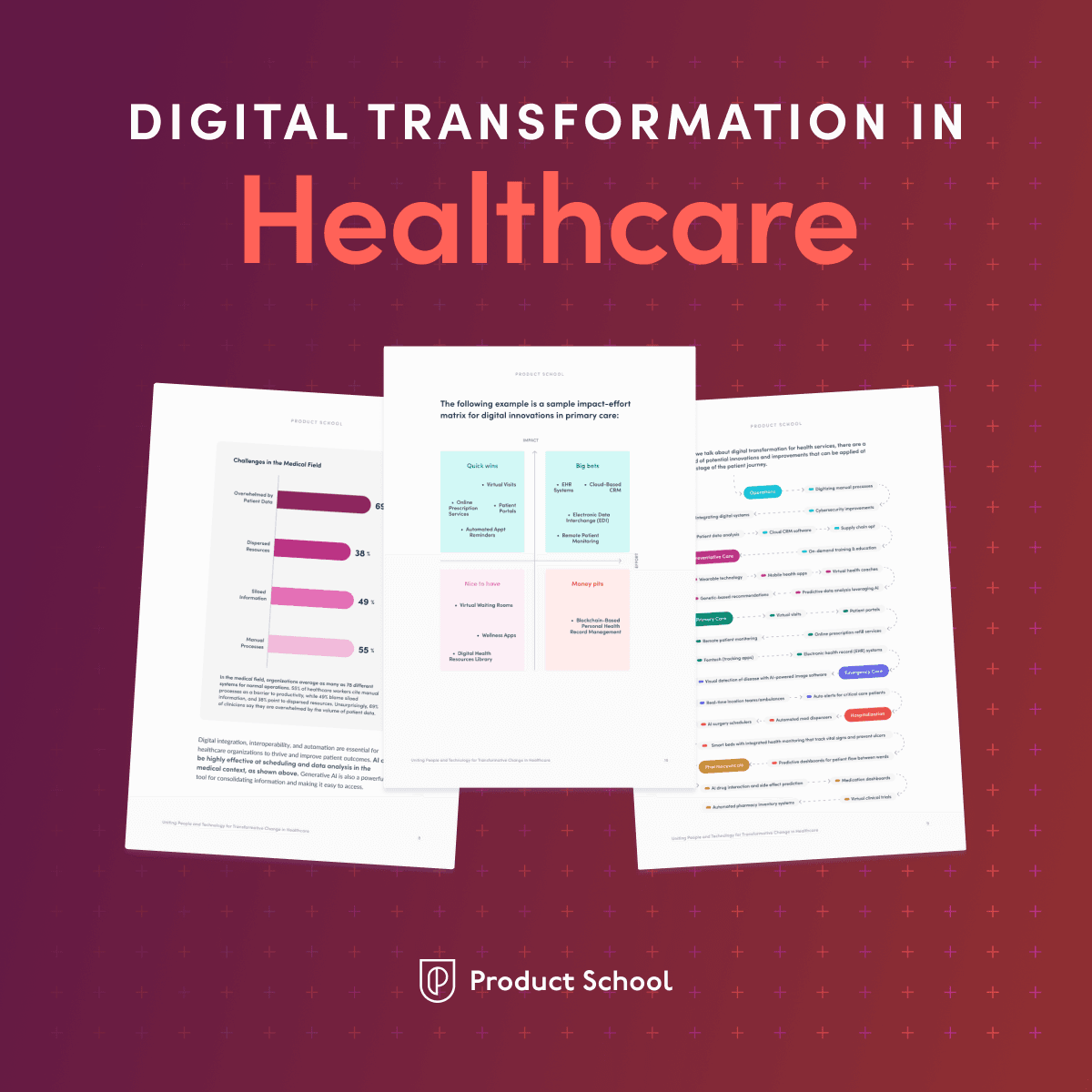Updated: June 12, 2025- 9 min read
The only constant in the corporate world is change and transformation. Embracing change has shaped my behavior; I actually look forward to those changes.
— Vinod Suresh, VP of Product at GoDaddy, on The Product Podcast
Picture a flock of birds, moving as one, shifting direction without chaos or hesitation, as if guided by a single mind. There’s no single leader, no loud commands — just subtle cues and quiet, unspoken alignment. Beautiful, right?
With change enablement, we can aspire to this kind of fluidity during change. Still, most digital transformations feel more like forcing square pegs into round holes. It’s where bits and pieces crack, where burnouts hit, and where a solid number of companies crumble.
Achieving ‘fluidity’, at least to a satisfying degree, isn’t about rigid control or exhaustive management — it’s about enabling change to happen as seamlessly as possible. By minimizing friction and avoiding unprepared shifts, change enablement processes make transformation feel less like an uphill battle and more like a natural evolution. Let’s dive into it.
Healthcare Industry Report
Dive into the latest research about digital transformation in healthcare in this white paper from Product School. Spark ideas with 6 case studies and over 25 digital solutions from operations to pharmaceuticals to primary care and more.
Download report
What Is Change Enablement?
Change enablement is the process of preparing and equipping individuals, teams, and organizations to adapt to new ways of working with minimal disruption.
At its core, change enablement prioritizes understanding the human aspect of, say, Agile Transformation. It’s about reducing friction by addressing the specific challenges that arise during change. The goal is to provide the right tools, resources, and support at precisely the right moments.
A change-positive culture is an essential element of successful enterprise transformations. Without effective change enablement processes, the transformation is likely to be among the 70% of digital transformations that fail.

Change enablement vs. change management?
Unlike change management, which focuses heavily on planning, control, and enforcement, change enablement centers on empowering people through a seamless, need-based approach. The goal is to navigate change confidently.
While change management often takes a linear, top-down approach with pre-defined stages, change enablement is more dynamic.
It acknowledges that individuals experience change differently and adapts accordingly. This approach focuses on fostering alignment, trust, and adaptability throughout the process rather than just meeting deadlines or ticking off milestones.
Key principles include:
Proactive Communication: Ensuring everyone understands the purpose and benefits of the change before it begins.
Resource Alignment: Providing tools, training, or knowledge exactly when it’s needed.
Feedback Loops: Listening to teams and adjusting strategies to reduce resistance in real time.
Instead of rigid plans, change enablement builds a framework where individuals feel prepared, supported, and involved.
How the change enablement process focuses on people
Change enablement is fundamentally people-centric. It recognizes that while systems and processes are vital, they’re only as effective as the people who operate within them. This approach shifts the spotlight from managing tasks to empowering individuals and teams. Here’s how it achieves that:
1. Understanding individual and team needs
Change enablement begins with understanding how change impacts employees at every level. Not everyone reacts to change the same way — some embrace it, while others resist it due to fear, uncertainty, or lack of clarity. By acknowledging these varied responses, organizations can tailor support to meet specific needs and unlock high performance during transformation.
2. Providing the right resources at the right time
A cornerstone of change enablement is delivering targeted support. Instead of overloading employees with information upfront, it breaks the process into manageable phases. Employees are given the tools, training, and information they need precisely when they need it, helping them feel more confident and less overwhelmed.
3. Building a culture of trust and collaboration
Change enablement thrives on trust. It emphasizes transparent cross-functional communication, involving employees in the conversation early to foster buy-in. Employees are treated as active participants, not passive recipients of change. This makes them more likely to not only support and engage with the process but lead the charge.
4. Reducing friction through personalization
Every team and individual experiences change differently. Change enablement minimizes disruption by tailoring strategies to specific roles or departments. For example, front-line employees might need hands-on training, while leadership might benefit from strategic briefings on change alignment.
5. Encouraging feedback and adaptation
Rather than imposing a fixed plan, change enablement incorporates feedback loops to adjust strategies in real time. By listening to employees’ experiences, organizations can address issues as they arise, further easing the transition.
A Practical Example of Change Enablement
Consider a company implementing a new CRM system to enhance customer engagement. In a traditional change management approach, the focus might be on delivering extensive training sessions and enforcing deadlines for adoption. While effective, this method alone can feel overwhelming and lead to resistance.
Change enablement, however, takes a more people-centered approach.
Before rolling out the CRM, employees are involved in the decision-making process. They share their input on what features would benefit them most. As the system launches, employees are gradually introduced to new features in digestible steps, accompanied by micro-training sessions tailored to their specific roles. Help desks or mentors are made available to provide immediate support for challenges.
This approach minimizes friction because employees don’t feel blindsided or overloaded. Instead, they feel equipped and confident, seeing the CRM as a tool they can grasp. They are able to see how it benefits their daily work rather than as an imposed disruption.
Benefits of Change Enablement Practices
Smoother Transitions
A people-first strategy supports employees and reduces resistance, leading to quicker adoption of new processes or technologies.Increased Engagement and MoraleInvolving employees in the process and addressing their concerns boosts engagement and fosters a positive attitude toward change.
Higher Productivity During Change
Minimizing disruption and confusion allows teams to maintain productivity, enabling employees to focus on their tasks without unnecessary stress.Increased Talent RetentionPrioritizing employee well-being during transitions demonstrates organizational commitment, improving job satisfaction and reducing turnover.
Enhanced Trust and Collaboration
Transparent communication and involvement create a culture of trust, aligning employees and leadership toward shared goals.Improved Long-Term Outcomes
Empowered employees are more adaptable, fostering organizational resilience and success in future transformations.Reduced Costs Associated with Change Resistance
Proactively addressing concerns lowers the risks of delays, retraining, and failed initiatives, saving time and resources.
How to Organize Change Enablement in 5 Steps
Organizing change enablement is a comprehensive process that requires balancing cultural transformations, new processes, tools, and measurable outcomes. Here’s a detailed, step-by-step guide tailored for product leaders aiming to lead a digital transformation effectively:
1. Align on vision and objectives
Without a unified product vision, efforts are fragmented. Leaders must clearly define why the change is necessary, what success looks like, and how it aligns with the company’s strategic goals.
Define the OKRs: Break down the goals into measurable outcomes like improving operational efficiency, enhancing customer satisfaction, or increasing ROI.
Involve key stakeholders early: Collaborate with product leadership, department heads, and influencers across the organization to ensure alignment.
Connect vision to business value: Make sure employees understand how the transformation benefits both the company and their roles. For example, “Implementing this tool will reduce repetitive tasks by 40%, freeing up time for strategic initiatives.”
Develop clear messaging: Craft a narrative around the vision that resonates with employees — focus on both logical and emotional appeals to gain buy-in.
2. Assess the current state
A realistic understanding of where the company stands in terms of culture, processes, tools, and skillsets helps identify gaps and challenges that could derail the change.
Audit processes and tools: Map existing workflows, tools, and systems to determine inefficiencies or redundancies.
Evaluate culture and mindset: Conduct surveys, interviews, or workshops to understand employees’ attitudes toward change. Identify cultural resistance points, such as fear of automation or misalignment with team values.
Identify skill gaps: Compare current employee capabilities with what the transformation demands. For instance, introducing AI-driven tools may require upskilling teams in data analysis.
Map dependencies: Understand interdepartmental processes and how one team’s workflow affects another.
3. Design a change enablement strategy
A tailored strategy ensures the change is introduced gradually and effectively, with minimal friction.
Create a roadmap: Outline short-term wins and long-term milestones. Prioritize initiatives based on impact and feasibility.
Develop targeted support plans: Segment employees by roles or departments and design specific support strategies. For example, customer-facing teams might need CRM training, while product teams may need agile coaching.
Choose the right tools: Select tools that align with the company’s goals and integrate seamlessly with existing systems. Always consider scalability and ease of adoption.
Establish growth metrics for success: Set metrics tied to business outcomes, such as reduced churn, increased productivity, or faster time-to-market.
The digital transformation roadmap below is one way to align the entire organization around common goals and plan initiatives:

4. Engage, train, and communicate
Change fails when employees feel unprepared or left out. Continuous communication and upskilling ensure smoother adoption and higher engagement.
Kick off with transparency: Host an all-hands meeting to explain the purpose, benefits, and roadmap of the transformation. Use stories, data, and visuals to illustrate the vision.
Provide role-specific training: Deliver micro-learning sessions, tutorials, or workshops tailored to each role’s needs.
Maintain two-way communication: Create feedback channels like Q&A sessions, surveys, or dedicated Slack channels to address concerns in real time.
Recognize early adopters: Highlight success stories or wins from teams or individuals who excel in embracing the change.
5. Monitor, measure, and adapt
Even the best plans need iteration. Tracking progress and making real-time adjustments ensures the change remains relevant and impactful.
Track metrics continuously: Use dashboards to monitor OKRs, such as employee engagement, productivity, and ROI on new tools.
Gather feedback at key milestones: Conduct retrospectives or feedback sessions after each phase to identify what’s working and what needs improvement.
Address resistance: Look for pockets of resistance and deploy targeted interventions, such as personalized coaching or additional resources.
Celebrate progress: Acknowledge milestones and share how they contribute to the broader vision. This reinforces trust and motivation.
Refine the strategy: Use insights from the implementation process to adjust your roadmap, tools, or training plans as needed.
Embracing Change Enablement for Lasting Growth
Change isn’t a one-time event; it’s a continuous evolution. An evolution we have to embrace, especially when digital transformation is becoming a must, not a choice.
Organizations that embrace change will thrive because of it. By focusing on people, aligning processes, and ensuring seamless transitions, change enablement transforms uncertainty into opportunity.
By empowering employees with the right tools, support, and guidance, change enablement fosters a culture of resilience and innovation. This approach not only helps teams adapt but also positions the organization for sustained success.
The future belongs to those who enable it. You’re the piece of the puzzle that can bring this knowledge forward and help your company thrive.
A Bold, New Approach to AI Training
Discover the only AI training system built for product teams. Leverage AI knowledge tailored to your team's workflows for increased experimentation velocity, time-to-value, and product adoption. Because the future of product leadership isn’t just about using AI—it’s about becoming AI-native.
Updated: June 12, 2025





